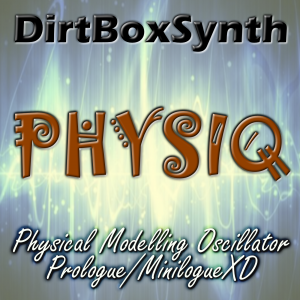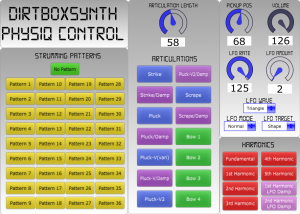
- Description
Physical Modelling Oscillator for Prologue & Minilogue XD
Physiq is a digital waveguide oscillator that emulates stringed instruments from around the world, including keyboard instruments, guitars, string and folk instruments.
At its core, Physiq uses a physical model that allows for control over many articulations, including finger picking, plectrum strumming, hammer striking, and bowing, all of which can be manipulated in real time. Virtual stings are excited by these articulations and the strings resonate at the played frequency, damped to simulate physical properties, and then passed through selectable instrument bodies.
Physiq main features:
- Multiple articulations – Strumming, plucking, picking, bowing, scraping
- Real-time / CC control of articulation speed
- String damping controls – volume, high frequency, tension, and damp tuning
- Pickup position control with LFO modulation
- Key-switching of articulations, strumming patterns, and harmonics
- Instrument body resonance modelling
- Includes MAC/PC controller app
Articulations
In the multi-engine parameter menu (PROGRAM EDIT), the ‘string excitations’, or ‘articulations’, can be selected with PGM EDIT 1, and the length of the current articulation is then controlled with the SHAPE control. This allows for different bowing speeds or pluck profiles, and offers different ways of exciting the virtual strings.
Each articulation also has some other ‘under the hood’ parameter changes that affect the excitation, including articulation length key-tracking, excitation profile, string excitation position and filtering.
Articulations (PGM EDIT 1)
- Strike – variable length
- Strike – variable length (damped)
- Pluck – fixed length (SHAPE controls excitement frequency)
- Pluck – fixed length / damped (SHAPE controls excitement frequency)
- Pluck – variable length
- Pluck – (damped)
- Pluck 2
- Pluck 2 (damped)
- Scrape
- Scrape (damped)
- Bow 1
- Bow 2
- Bow 3
- Bow 4
- Strumming
- More strumming patterns from here on…
Strumming / Note Patterns
There are a number of built-in patterns that can be used for strumming and note picking, these can be accessed from the Articulation parameter as above, or by key-switching. If using the articulation control (PGM EDIT 1), the ‘strike type’ is fixed, but if using MIDI note key-switching, any articulation can be chosen.
The speed and sync of strumming patterns is controlled by the internal LFO (so can be sync’ed to tempo), and can create some interesting rhythm variations with various LFO sync settings. These patterns can be used for other rhythmic repetition, like fast repetitive picking (tremolo picking), or finger-picking.
For the strumming to play, the LFO must be set to modulate SHAPE, and a small amount of LFO must be set.
Please note: Physiq is designed for polyphonic use, and may not behave as expected in mono mode, and as such is not designed for the Korg NTS-1 synth, although technically it will still work.
‘Pickup Position’
The ‘listening position’ along the virtual string can be controlled with SHIFT-SHAPE, which varies the tone dramatically, eg. from a classical guitar sound to an electric guitar, or the sound from different electric guitar pickup positions.
The internal LFO also modulates the ‘listening position’ or ‘pickup position’ of the string, creating a natural phasing effect.
On a side note, if the internal LFO is set to pitch modulation, then this can create some pretty wild effects, but beware… if the LFO range is too high it may switch in some unintentional key-switching changes or silent voices, and seriously mess your sound! This is unavoidable, unfortunately, due to the way the Korg SDK is set up – modulating pitch with LFO actually changes the MIDI note received by the oscillator. Just remember it might go a bit crazy if you use wide pitch to LFO mod!
Damping
There are three types of damping that can be manually controlled to affect how the strings decay after being excited with an articulation – Volume, High Frequency, and Tension Damping.
- Volume damping will cause the vibrations to stop very quickly, with no regard for frequency.
- The high frequency damping control makes higher frequencies be damped more quickly.
- The tension of the strings can be altered so that strings can either vibrate freely, or be ‘tighter’ and dampen higher vibrations, creating more muted notes with a ringing effect.
The amount of each type of damping is set independently with PGM EDIT 2-4.
Both the Tension Damping and HF Damping frequencies are set with PGM EDIT 5, determining above what frequency the damping occurs.
A fourth damping is built in as part of certain articulations. This is fixed high frequency damping that operates alongside the manual controls. These are coloured purple in the CTRLR app (see below).
The non-damped articulations can continue indefinitely (or at least until the amp envelope has faded), so these un-damped articulations are good for keyboard sounds, as they can be made to sustain for much longer, and are affected more by the manual damping controls.
Body Resonance
Within the physical modelling engine, the excited, and then damped, string oscillations are fed into an instrument ‘body resonator’ as it would on a real instrument.
There are numerous body resonators to choose from (PGM EDIT 6), representing different body sizes, material choice and characteristics that change the overall tone of the instrument.
Physiq Parameter Summary
SHAPE Length of articulation (usually)
SHIFT_SHAPE Pickup position (LFO modulated)
Edit 1 Articulation / strumming pattern select
Edit 2 Volume Damping
Edit 3 High Frequency Damping
Edit 4 Tension Damping
Edit 5 Damping Frequency (HF and Tension)
Edit 6 Body resonance preset
LFO Strum timing / Pickup position modulation / Harmonic LFO Damping
Physiq Key-switching
To access many variations, low and high MIDI notes can trigger changes in articulation, strumming patterns, and harmonic type.
Key-switching articulations
Each articulation can be changed via key-switching, where some MIDI notes don’t play actual notes, but change the articulation to be played the next time the note is struck. One peculiarity of key-switching on the Prologue/Minilogue XD, is that for the same articulation to be played on every voice, the key-switch note must be pressed rapidly a number of times (4 time for the XD, 8 for the Prologue 8 etc). As an interesting by-product of this, different voices can actually be set for different articulations, so for example, alternating articulations could be played on consecutive notes, or chords can consist of mixed articulations, but the nature of voice allocation may throw in some surprises!
Key-switching strum patterns
Strumming pattern key-switches are split between low and high MIDI notes – (simply to have as many patterns as could fit!) It is also possible to have different patterns on different voices, as with articulations.
Key-switching harmonics
Harmonics can only be accessed using key switches, and are not available through any other control. These select either the fundamental note, a choice of harmonics (fundamental to fifth harmonic), or ‘harmonic LFO damping’.
With harmonic LFO damping, the LFO amount will modulate the pitch of the harmonic, which has the effect of damping that harmonic but with LFO modulation. This creates quite unnatural, but interesting modulated pitch-related damping that can make for interesting modulated percussion sounds. If using harmonic LFO damping, the pickup position is not modulated by the LFO.
Key-switch MIDI note map:
| MIDI note | Keyswitch Action |
| 0 – 13 | Articulation 1 – 14 (PGM EDIT 1: 1-14) |
| 14 – 21 | Harmonics type 1-8 |
| 22 – 30 | Strumming Pattern 1 – 9 (PGM EDIT 1: 15-23) |
| 31 – 99 | ‘Real’ notes (notes G1 – Eb7) |
| 100 – 125 | Strumming Patterns 10 – 36 (PGM EDIT 1: 24-52) |
Physiq MAC and PC app
To assist with key-switching and parameter editing, a CTRLR panel is included with Physiq. This can be loaded onto your MAC or PC, and used to control your ‘Logue synth.
The app allows you to send key-switch changes to all voices simultaneously, and control some other parameters.
CC controllers:
Volume User oscillator volume
Pickup Position CC controller for SHIFT_SHAPE
Articulation Length CC controller for SHAPE
LFO controls CC controllers for all LFO settings
Key-Switching:
Some features of Physiq are only accessible with the Physiq App, or by sending the appropriate key-switching MIDI notes to control the oscillator.
The following can be controlled via key switches in CTRLR or by MIDI notes:
- Articulation Same as PGM EDIT 1, but only up to strum articulation (#15)
- Strumming Pattern Same patterns as EDIT 1 from (#15), but independent of articulation
- Harmonics A choice of fundamental, harmonic, or harmonic LFO damping
Key-switching via CTRLR is done by sending multiple note on and note offs of a particular MIDI note. This is done so that every voice on the synth is updated. If only one note is sent, then only one voice will get updated.
Should you wish to make one voice a different articulation to the others, then a single note would need to be sent to update the next available voice – this is a great way to make note sequences with varying articulations, patterns or harmonics.
If a note is being held down, then that voice will NOT be updated with the articulation, harmonic, or pattern key-switch. This is one way to create those varying patterns. This feature also means that when key-switching ahead of the next note, the currently playing note will not be interrupted, but the held note voice won’t have the new key-switch assigned until it is updated with another key-switch assignment.
Please note – There are two versions of the CTRLR app: An 8/4-voice version (for Prologue 8 and Minilogue XD), and a 16-voice version (for Prologue 16). The difference is in the number of MIDI notes that are updated.
To use the CTRLR in standalone mode, open the correct file (MAC or PC , sixteen or eight version), and set the MIDI inputs from the menu: MIDI->Input->Device->’minilogue xd 1 KBD/KNOB’ (or Prologue etc), and set the outputs: MIDI->Output->Device->’minilogue xd 1 SOUND’. You may find that you cannot use the CTRLR app and the Korg Librarian simultaneously, due to drivers.
If when you open the app it is in edit mode, then to switch to ‘play’ mode, either go to the menu Panel>Panel Mode, or just press ctrl/apple-E to switch modes.
Physiq playing some ‘real’ instruments!

